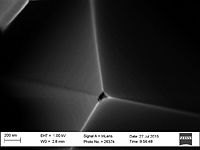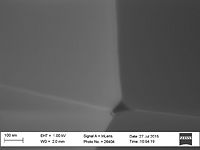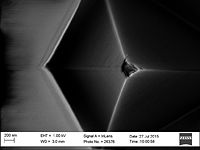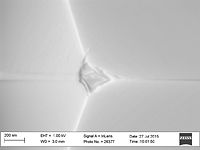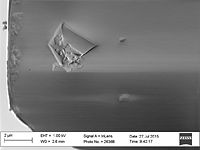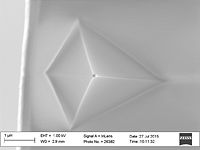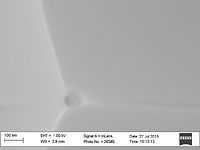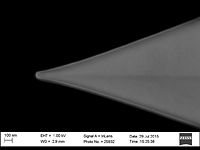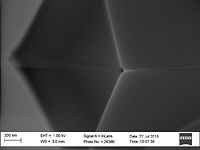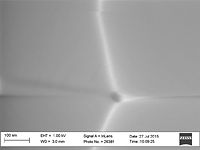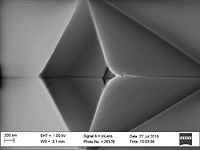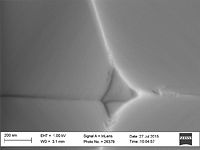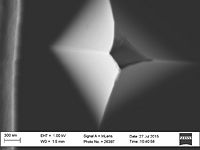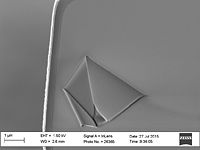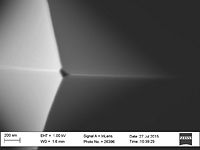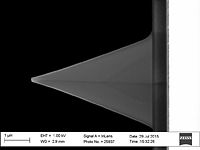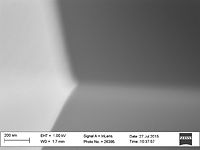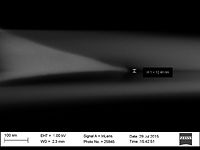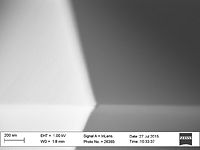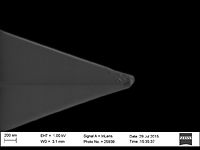Specific Process Knowledge/Characterization/AFM: Atomic Force Microscopy/Workspaces: Difference between revisions
| (53 intermediate revisions by the same user not shown) | |||
| Line 1: | Line 1: | ||
'''Feedback to this page''': '''[mailto:labadviser@danchip.dtu.dk?Subject=Feed%20back%20from%20page%20http://labadviser.danchip.dtu.dk/index.php/Specific_Process_Knowledge/Characterization/AFM:_Atomic_Force_Microscopy/Workspaces click here]''' | '''Feedback to this page''': '''[mailto:labadviser@danchip.dtu.dk?Subject=Feed%20back%20from%20page%20http://labadviser.danchip.dtu.dk/index.php/Specific_Process_Knowledge/Characterization/AFM:_Atomic_Force_Microscopy/Workspaces click here]''' | ||
''This page is written by Berit Herstrøm @ DTU Nanolab '' | |||
=What scanning mode, experiment/workspace and probe should I select= | =What scanning mode, experiment/workspace and probe should I select= | ||
| Line 13: | Line 15: | ||
!Steep/abrupt steps but no high aspect ratio | !Steep/abrupt steps but no high aspect ratio | ||
!High aspect ratio measurements | !High aspect ratio measurements | ||
!Large area fast scan | |||
|- | |- | ||
| Line 18: | Line 21: | ||
|-style="background:WhiteSmoke; color:black" | |-style="background:WhiteSmoke; color:black" | ||
!Recommended mode | !Recommended mode | ||
|Roughness measurement can be done in both Contact, Tapping and ScanAsyst mode. We recommend '''ScanAsyst mode''' because of less chance of (non-uniform) deformation of the sample and less tip wear - and because of ease of use. | |Roughness measurement can be done in both Contact, Tapping and ScanAsyst mode. We recommend '''ScanAsyst mode''' because of less chance of (non-uniform) deformation of the sample and less tip wear - and because of ease of use. However it also works fine in tapping mode. | ||
|For Topographic measurements with no steep/abrupt steps we also recommend ''' | |For Topographic measurements with no steep/abrupt steps we also recommend '''Tapping mode''' on most samples. Only on very soft samples (e.g. cells) we recommend ''ScanAsyst'' due to less chance of (non-uniform) deformation of the sample - or if you need QNM data. We mainly recommend '''Tapping mode''' because we experience less problems when the tip end is slightly broken. | ||
|For Steep/abrupt steps but no high aspect ratio structures we still recommend ''' | |For Steep/abrupt steps but no high aspect ratio structures we still recommend '''Tapping mode''' unless you need need QNM data. | ||
|For High aspect ratio measurements we recommend Tapping mode. | |For High aspect ratio measurements we recommend Tapping mode. We do not have experience with ScanAsyst therefore we recommend '''Tapping mode'''. | ||
|For large scan areas where you prioritize to scan fast then you can use '''contact mode'''. Here you can scan with scan rate of up to 2.43 Hz | |||
|- | |- | ||
| Line 27: | Line 31: | ||
|-style="background:LightGrey; color:black" | |-style="background:LightGrey; color:black" | ||
!Recommended probes | !Recommended probes | ||
|'''[http://www.brukerafmprobes.com/p-3726-scanasyst-air.aspx ScanAsyst in air]''' | |'''[https://www.nanoandmore.com/AFM-Probe-Tap150Al-G Tap150Al-G]''' or '''[http://www.brukerafmprobes.com/p-3726-scanasyst-air.aspx ScanAsyst in air]''' | ||
|'''[http://www.brukerafmprobes.com/p-3726-scanasyst-air.aspx ScanAsyst in air]''' | |'''[https://www.nanoandmore.com/AFM-Probe-Tap150Al-G Tap150Al-G]''' or '''[http://www.brukerafmprobes.com/p-3726-scanasyst-air.aspx ScanAsyst in air]''' | ||
|'''[http://www.brukerafmprobes.com/p-3726-scanasyst-air.aspx ScanAsyst in air]''' for ScanAsyst mode | |'''[https://www.nanoandmore.com/AFM-Probe-Tap150Al-G Tap150Al-G]''' or '''[http://www.brukerafmprobes.com/p-3726-scanasyst-air.aspx ScanAsyst in air]''' for ScanAsyst mode | ||
'''[http://www.nanoandmore.com/AFM-Probe-Tap300Al-G | '''[https://www.nanoandmore.com/AFM-Probe-Tap150Al-G Tap150Al-G]''' or '''[http://www.nanoandmore.com/AFM-Probe-Tap300Al-G TAP300Al-G]''' for Tapping mode | ||
|'''[http://www.nanoandmore.com/AFM-Probe-AR5T-NCHR | |'''[http://www.nanoandmore.com/AFM-Probe-AR5T-NCHR AR5T-NCHR]''' or | ||
'''[http://www.brukerafmprobes.com/p-3679-fib6-400a.aspx FIB6-400A]''' | '''[http://www.brukerafmprobes.com/p-3679-fib6-400a.aspx FIB6-400A]''' | ||
|'''[https://www.brukerafmprobes.com/p-3693-snl-10.aspx SNL]''' | |||
|- | |- | ||
| Line 39: | Line 44: | ||
!Recommended experiment/Workspace | !Recommended experiment/Workspace | ||
| | | | ||
Check the user manual in LabManager | |||
| | | | ||
Check the user manaual in LabManager | |||
| | |Check the user manaual in LabManager | ||
|'''TappingMode 300nm trench''' (for steps <~1µm) | |'''TappingMode 300nm trench''' (for steps <~1µm) | ||
'''Tappping mode in air - 6µm Deep Trench''' (for steps >1~µm) | '''Tappping mode in air - 6µm Deep Trench''' (for steps >1~µm) | ||
|'''Standard Contact mode''' | |||
|- | |- | ||
|} | |} | ||
'''*'''By choosing the work space/experiment ''QNM in air'' (Mechanical properties - QNM in air) | '''*'''By choosing the work space/experiment ''QNM in air'' (Mechanical properties - QNM in air) ''scanAsyst'' is included and so are the nanomechanical properties like modulus, adhesion, dissipation and deformation. | ||
<br clear="all" /> | <br clear="all" /> | ||
| Line 55: | Line 61: | ||
==More information about de different modes== | ==More information about de different modes== | ||
===Contact, Tapping and Peak Force Tapping=== | ===Contact, Tapping and Peak Force Tapping=== | ||
Please flowing this link to | Please flowing this link to down load the file from LabManager (Requires login): <br> | ||
[ | [https://labmanager.dtu.dk/view_binary.php?fileId=5340 Introduction to Bruker ScanAsyst and PeakForce tapping AFM technology] | ||
===PeakForce tapping and quantitative nanomechanical mapping=== | ===PeakForce tapping and quantitative nanomechanical mapping=== | ||
*Application note on QNM: [https://labmanager.dtu.dk/view_binary.php?fileId=5404 requires login] | |||
[ | |||
===Peak Force KPFM (Kelvin Probe Force Microscopy)=== | ===Peak Force KPFM (Kelvin Probe Force Microscopy)=== | ||
*Application note on KPFM: [[File: PeakForce-Kelvin-Probe-Force-Microscopy-App-Note-BRUKER.pdf]] - used with permission | |||
[ | |||
=Evaluation of used probes= | |||
{| border="1" cellspacing="1" cellpadding="2" align="left" | |||
! Box number and probe number | |||
! User Initials | |||
! Explanation | |||
! SEM images | |||
! Conclusion | |||
|- | |||
|Box1 no. 1||bghe||A lot of triangles in the image||[[File:Box1 no1 tilt0_26.jpg|200px]][[File:Box1 no1 tilt0ny2_56.jpg|200px]]||Tip end has broken off | |||
|- | |||
|Box1 no. 2||bghe/smurthy||Round pillars became misshaped||[[File:Box1 no2 tilt0ny2_55.jpg|200px]]||Tip end has broken off or maybe if was not good to begin with | |||
|- | |||
|Box1 no. 3||bghe/zhongli||Force curve bad, could not get the tip off the surface||[[File:Box1 no3 tilt0_28.jpg|200px]][[File:Box1 no3 tilt0_29.jpg|200px]][[File:box1 no3 90dg_03.jpg|200px]]||Tip end has broken off | |||
|- | |||
|Box1 no. 4||mattod||Used dirty sample, force curve very bad, tip probably broken||[[File:Box1 no4 tilt21_10.jpg|200px]]||The hole cantilever has broken off | |||
|- | |||
|Box1 no. 5||mattod||Tip broken during tip change||[[File:Box1 no5 tilt21_20.jpg|200px]]||Tip/cantilever has been damaged | |||
|- | |||
|Box1 no. 6||abshir||Bad force curve (fluctuates)||[[File:Box1 no6 tilt0_34.jpg|200px]][[File:Box1 no6 tilt0_35.jpg|200px]][[File:box1 no6 90dg_00.jpg|200px]]||Tip end has broken off | |||
|- | |||
|Box1 no. 7||bghe||Was OK on large structures but they got larger||[[File:Box1 no7 tilt0_32.jpg|200px]][[File:Box1 no7 tilt0_33.jpg|200px]]|| | |||
|- | |||
|Box1 no. 8||mattod||Bad force curve||[[File:Box1 no8 tilt0_30.jpg|200px]][[File:Box1 no8 tilt0_31.jpg|200px]]||Tip end has broken off | |||
|- | |||
|Box1 no. 9||kabi||Blunt tip . Definitely (triangles)||[[File:Box1 no9 tilt0ny2_49.jpg|200px]][[File:Box1 no9 tilt21_17.jpg|200px]]||Tip end has broken off | |||
|- | |||
|Box1 no. 10||kabi||Blunt tip. Definitely (triangles)||[[File:Box1 no10 tilt0ny2_48.jpg|200px]][[File:box1 no10 90dg_05.jpg|200px]]||Tip end has broken off | |||
|- | |||
|Box2 no. 1||mattod||Bad force curve||[[File:Box2 no1 tilt0ny2_46.jpg|200px]][[File:Box2 no1 tilt0ny2_47.jpg|200px]][[File:box2 no1a 90dg_13.jpg|200px]]||Tip seems ok, or at least very close to okay | |||
|- | |||
|Box2 no. 2||mattod||Broken tip||[[File:Box2 no2 tilt0ny_44.jpg|200px]][[File:Box2 no2 tilt0ny_45.jpg|200px]][[File:box2 no2 90dg_11.jpg|200px]]||It looks like the tip end has been contaminated | |||
|- | |||
|Box2 no. 3||bghe||Got large triangle scanning the tip checker||[[File:box2 no3 90dg_07.jpg|200px]]||Tip end has broken off | |||
|- | |||
|} | |||
Latest revision as of 15:33, 28 April 2023
Feedback to this page: click here
This page is written by Berit Herstrøm @ DTU Nanolab
What scanning mode, experiment/workspace and probe should I select
| Roughness measurements | Topographic measurements with no steep/abrupt steps | Steep/abrupt steps but no high aspect ratio | High aspect ratio measurements | Large area fast scan | |
|---|---|---|---|---|---|
| Recommended mode | Roughness measurement can be done in both Contact, Tapping and ScanAsyst mode. We recommend ScanAsyst mode because of less chance of (non-uniform) deformation of the sample and less tip wear - and because of ease of use. However it also works fine in tapping mode. | For Topographic measurements with no steep/abrupt steps we also recommend Tapping mode on most samples. Only on very soft samples (e.g. cells) we recommend ScanAsyst due to less chance of (non-uniform) deformation of the sample - or if you need QNM data. We mainly recommend Tapping mode because we experience less problems when the tip end is slightly broken. | For Steep/abrupt steps but no high aspect ratio structures we still recommend Tapping mode unless you need need QNM data. | For High aspect ratio measurements we recommend Tapping mode. We do not have experience with ScanAsyst therefore we recommend Tapping mode. | For large scan areas where you prioritize to scan fast then you can use contact mode. Here you can scan with scan rate of up to 2.43 Hz |
| Recommended probes | Tap150Al-G or ScanAsyst in air | Tap150Al-G or ScanAsyst in air | Tap150Al-G or ScanAsyst in air for ScanAsyst mode
Tap150Al-G or TAP300Al-G for Tapping mode |
AR5T-NCHR or | SNL |
| Recommended experiment/Workspace |
Check the user manual in LabManager |
Check the user manaual in LabManager |
Check the user manaual in LabManager | TappingMode 300nm trench (for steps <~1µm)
Tappping mode in air - 6µm Deep Trench (for steps >1~µm) |
Standard Contact mode |
*By choosing the work space/experiment QNM in air (Mechanical properties - QNM in air) scanAsyst is included and so are the nanomechanical properties like modulus, adhesion, dissipation and deformation.
More information about de different modes
Contact, Tapping and Peak Force Tapping
Please flowing this link to down load the file from LabManager (Requires login):
Introduction to Bruker ScanAsyst and PeakForce tapping AFM technology
PeakForce tapping and quantitative nanomechanical mapping
- Application note on QNM: requires login
Peak Force KPFM (Kelvin Probe Force Microscopy)
- Application note on KPFM: File:PeakForce-Kelvin-Probe-Force-Microscopy-App-Note-BRUKER.pdf - used with permission

